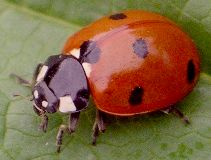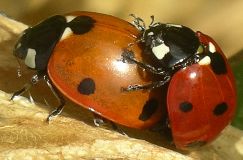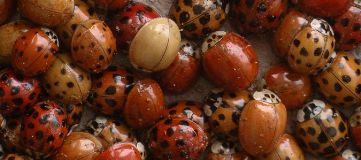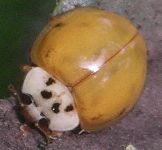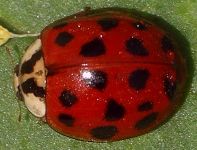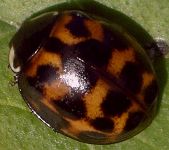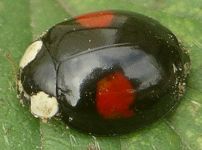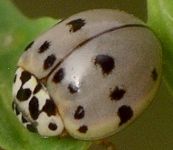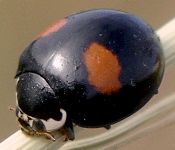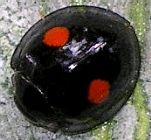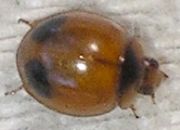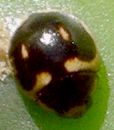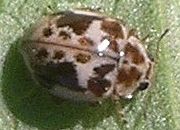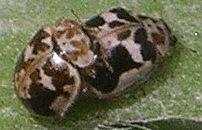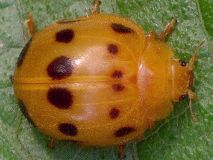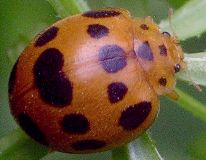
| Coccinellidae ~ Ladybird Beetles |
page 1 ![]() page 2
page 2
|
The Spotted Ladybird Beetle (Coleomegilla maculata) is another all red species. For a ladybug, it is rather elongate and long-legged, so it is not easy to confuse with any other species. The spots are fairly consistent from one individual to another, but the base color ranges from pink to deep red, with males usually darker than females.
The picture-perfect ladybug has to be the Seven-spotted Ladybird Beetle (Coccinella septempunctata). This introduced species is one of our largest, often reaching about 6 mm in length. It is fairly common and is sometimes the predominant species in a particular area. The color ranges from light to dark orange, with males often darker than females. The seven black spots are almost always the same, although there can be additional smaller black marks that sort of mess up the perfect pattern. The pronotum is black with small white squares at the front corners.
By far our most numerous species is another import: the Asian Multicolored Ladybird Beetle (Harmonia axyridis). In many parts of the country, this ladybug regularly enter homes during cold weather to hibernate. We don't often have this phenomenon here, probably because the species' numbers are not so large due to hot, dry summers, and also the winters are rather mild. However, sometimes a wet summer will produce a bumper crop of ladybugs and they do what comes naturally: congregate in protected areas to wait out the winter. I've seen them cluster in corners of sheds and greenhouses by the thousands. It is impressive.
True to its name, the Asian Multicolored Ladybird Beetle comes in a wide variety of colors and patterns, from light tan to deep red, and spots may be so large that they blend together or they may be totally absent. One color form, which I've only seen once out of thousands of individuals, is black with two large red spots! In spite of all the possible colors and patterns, it IS possible to learn to recognize this species. One good clue is that they are fairly good-sized (about 5 mm in length) and very round. Another is the pronotum, which usually has a black pattern that looks like a W or an M, depending on your orientation. This pattern can be very light and thin, or it can swell so that most of the pronotum is black. When it is not obscured, the center part of the W or M is thinner than the outer parts. The outer sides of the pronotum almost always have large white marks (yes, there are sometimes exceptions to this, too, but not often).
There is a less common species that is quite similar in size and shape to the Asian Multicolored Ladybird Beetle, and that is the Ashy Gray Ladybird Beetle (Olla v-nigrum). This beetle has two distinct color forms, one of which is black with two large red spots. In this form, it can be separated from H. axyridis by the shape of the white on the sides of the pronotum and the white markings on the face. Another clue is that the black color form of the Asian Multicolored Ladybird Beetle is simply not very common. The other color form of the Ashy Gray Ladybird Beetle is gray. I think it is obvious where the common name originated. The markings on the pronotum of this color form are very much like those of the Asian Multicolored Ladybird Beetle, but there is also a black dot in the large white spot on each side. The black spots on the elytra might vary in size, but are always in the same pattern. I've never seen a gray Asian Multicolored Ladybird Beetle, so that color is a pretty reliable clue.
While we are on the subject of black ladybugs with two large red spots, there is yet another species with those marks: the Twice-stabbed Ladybird Beetle (Chilocorus stigma). This is a small species (about 3-4 mm in length) that is all black and very shiny. There is a slight lip around the edge of the elytra and pronotum, making it difficult to dislodge the beetle when it is on a smooth surface. The red spots can be small or large, but they are always fairly round. This ladybug specializes in feeding on scale insects and it has cleared up infestations on our maple trees, as well as several other yard plants.
Not all ladybird beetles are in the 5 mm or so size range. Many are much smaller. One genus that has several species is Brachiacantha. These oval-shaped shiny beetles are usually about 2-3 mm in length. The larvae are not usually encountered because they feed on scale insects within ant colonies. Adults are sometimes found on flowers or hunting within foliage. I've seen Brachiacantha decora several times during the spring. The three sets of light markings and the face vary from red to orange to cream. The face and pronotum may have extensive light marks or be mostly black. The largest spots on the elytra are sort of hourglass shaped.
An uncommon species (or easily overlooked because of the small size) is Brachiacantha quadrillum. The red marks on this one include two spots near the rear and two on the sides of the pronotum. Brachiacantha subfasciata has two large irregular red spots. Its small size will distinguish it from other two-spotted black ladybugs such as the Twice-stabbed Ladybird Beetle. Exochomus childreni is a tiny species that is just under 3 mm in length. It is orange with black on the pronotum and two large black spots near the rear of the elytra.
While there are a number of Hyperaspis species in Texas, I've only seen one, probably owing to the extremely small size. Hyperaspis trifurcata is a 2 mm long widely rounded beetle with graceful yellowish markings. These can vary somewhat, but are usually similar to those in the accompanying photo. I've only seen this insect on prickly pear cactus, where it races around constantly, making it a difficult photo subject.
One of the most ornately marked ladybird beetles is also one of the smallest. Psyllobora renifer is a 2 mm long tan beetle with brown markings. These spots and blobs can vary considerably, but the overall look of the Rorschach-like markings are generally similar between individuals. Occasionally, this species can be rather numerous.
The genus with the most species in our area is Scymnus. I cannot tell one species from another in this group, as they are only 2 mm in length and pretty much look like a moving flower seed. They are dark with reddish brown markings on the rear and pronotum. The face is usually tan. Although it's hard to see, these beetles are covered with fine hairs, which gives them a dusty appearance. The larvae, described on the previous page, are actually easier to find than the adults.
There is one black sheep in our local ladybird beetle fauna, and that is the Squash Ladybird Beetle (Epilachna borealis). This large round orange ladybird beetle (about 6 mm in length) does not feast on aphids but on squash and related plants. It could probably become a pest in a garden, but I've only seen it in wild areas where it is not very common. It is distinguished from other ladybird beetles in being all orange, with no white on the head or pronotum, and the texture of its whole body is more translucent than other members of the family. The elytra have fine lines that look sort of like veins, and the whole beetle is covered in fine hairs, giving it a matte appearance much unlike the usual shiny texture of other ladybird beetles. It reminds me of a small dusty ripening tomato with black spots. The spots vary in size, but their placement follows the same pattern on most individuals. The spots on the pronotum may be absent. |
page 1 ![]() page 2
page 2
![]()


